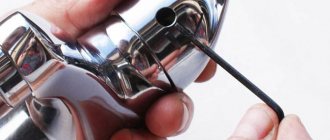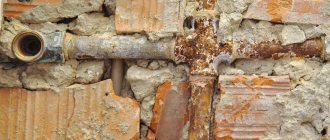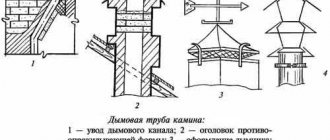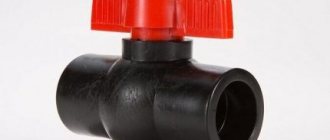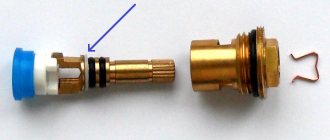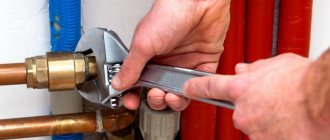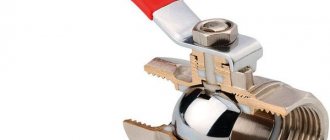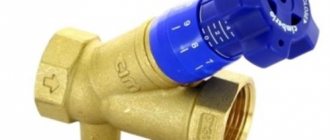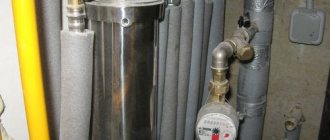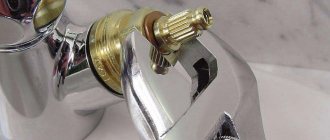Design features
Today, ball valves are the most widely used. It should be noted that the most common connection method is the coupling method, but the connection can also be made by welding. Similar models have the following design:
- The valve body acts as the main element. The fact that the connection is made using welding technology determines the use of special steel that can withstand high temperatures. The body is characterized by the absence of various protrusions, thereby eliminating the possibility of dirt accumulation.
- The ball is used as the main locking element. Stainless steel is used in its manufacture; in the central part there is a hole with different patency.
- Control is carried out using the handle. It has a shape that makes it easy to operate the device.
- The spindle is used to directly connect the handle to the ball. The shape of such an element is quite complex, which allows the installation of several compaction wheels. It is worth considering that the spindle is installed from the inside, which ensures a high degree of reliability when operating the device under pressure.
- Inside the faucet there is a ball seat, which is made of Teflon. This material is characterized by high resistance to mechanical stress.
- The locking pin limits the rotation of the handle.
We will pay special attention to the fact that the inlet and outlet pipes are represented by tubes made of metal, which can be easily welded. There are no threads or other elements on the surface, which complicate the welding process
Single lever mixer device
The design of a single-lever crane is represented by the following elements:
Based on the typical features of a single-lever faucet, the device can be equipped with a ball or ceramic cartridge. The design of ball-cartridge models is represented by a full ball with holes and connected to the handle with a pin. Through paired inlet holes, the ball chamber is filled with cold and hot water, followed by mixing and flowing into the spout. Temperature and water pressure are adjusted using ball joints. The inlets are sealed with Teflon.
A faucet with a ceramic cartridge has a pair of closely ground ceramic plates (washers) that move when the handle is turned. Water mixing and pouring flow occurs due to the alignment of the provided washer holes. Some models are distinguished by the presence of a limiting ring that controls the supply of hot water. The outer surface of the cartridge holes is protected in the form of silicone or plastic rubber gaskets. To ensure low-noise operation and limit the mixer from water hammer, the upper washer is equipped with small scars or stripes. It is impossible to disassemble a ball valve of this type - only its complete replacement is required.
Ball valve installation
In this article I will tell you how to correctly install a ball valve on water supply and heating pipes, but first I will tell you a little about the pros and cons of ball valves. At the moment, such valves are the most common, popular, and very practical and convenient; their undoubted advantage over old-style faucets is that there is no need to change the gaskets, since they have a different device and operating principle. There is a ball inside the faucet, in one position it is open, and when turned 90 degrees, the water is shut off, but there are also big disadvantages to ball valves: If the water is bad, the ball can become clogged, and if you do not turn it for a year, especially on hot water, then close it it becomes very difficult, and sometimes impossible, so you need to turn it at least once every 2 months to remove salt deposits.
If rusty water comes from the tap, then when opening and closing, scale or sand can damage the surface of the ball, and then the tap will etch in the closed position. On ball valves of average quality, with frequent opening and closing (most often found on hot water and heating), a leak begins from under the seal, of course it can be tightened, but in many cases the nut that tightens the seal rotates along with the lever and continues to drip, and Some taps do not have a seal at all, and if there is a leak, you can only throw it away and install a new one. And one more minus, you cannot install a ball valve in a room where the temperature may be less than 0 degrees in winter; when the water freezes, it breaks.
How to install a ball valve on a pipe
When installing a ball valve on a pipe, you must:
1. If you are replacing a faucet, you need to remove the old one, clean the threads of flax, and try screwing on the faucet. More than once I have encountered the problem that when removing an old valve, 2-3 turns rot, in which case it is necessary to trim the threads. The tap must be screwed onto the pipe with at least 4 turns!
2. If, when dismantling the old tap, the threads remained in normal condition, but when installing the tap, the tap is screwed on less than 4 turns, be sure to drive the threads with a die!
3. Check that the tap is screwed on 4-5 turns without flax, wind the flax. and tighten it 4-5 turns.
4. If you are installing plumbing or heating, then first accurately measure where the ball valve will be installed, cut it in the right place, cut the thread on the pipe, and screw it 4-5 turns.
And as usual, a few tips, if you have a centralized heating supply, and there is high pressure in the system, use ball valves from Bugatti, they have proven themselves very well, do not install valves that do not have an oil seal, if it starts to leak, you will not be able to fix it before replacing the faucet.
Ball valves come with internal threads on both sides, internal - external, external - external, and internal on one side, and on the other American, so calculate and buy those that are needed for further connection of the water supply or heating.
Watch the video, installation, installation of a ball valve, and how to cut a thread on a pipe.
Answers from experts
Alexander Eremin:
Better fum tape for threads...
ban:
For sealing, fluoroplastic tapes FUM, FLUP, and similar materials are used. By the way, both ends are sealed.
Ilya Prokhorov:
The faucet is one of the best (manufacturer). There is no need for a gasket; you need a winding on the external thread, which will be screwed into the internal thread of the faucet. For convenience, you can take “Tangit Unilock”, everything is simple and very reliable!
RantaHun:
wrap it in foam +
Vladimir:
It might be really bad. When you turn it back on, the water will try to tear the valve out of the stem, but it’s just rolled there. Then the tap won’t turn off the water in any way, and another malfunction may occur; this very valve will dangle. the tap will “sing”. Normally, the water pressure should tend to push out the valve. Valves: a - with a special bushing; b - with a union nut; 1 - body; 2 - nut; 3 — washer; 4 — rubber gasket; 5 - valve; 6 - gasket; 7 — rod; 8—body head; 9 — oil seal; 10 — special bushing: 11 — flywheel; 12 — washer; 13 - screw; 14— union nut; 15 — oil seal bushing; 16—oil seal ring
Wawan Bik:
DO NOT DO THIS AGAINST THE SEAL
Vladimir:
Yes, nothing bad will happen! When you need to keep it at 100% - this is exactly how the mechanics install the valves in the shaft!
Alexander Egorov:
the saddle will wear out more
Sergey:
don't give a damn about the ball, but with the valve axleboxes the gasket will be squeezed out and run out of the seal even with the valve closed
And also the collapsible ball ones have a body made of 2 halves. If you screw a small part to the inlet and hit it on the tap and it comes off or cracks, you’ll turn off the hell
KERK:
On a used (worn out) faucet, pressure can even knock off the locking washer. And you will get a constantly closed valve!
Sergey Martynov:
Nothing will happen unless they have a check valve or a dirt filter.
Free wind:
Strongly! If the valve fails, you won’t be able to close it or fix it, and you’ll flood the whole house….
Features of the resulting compound
Despite the fairly widespread use of coupling and flange connection methods, some ball valves are connected using welding. This connection method can be characterized as follows:
- It is possible to connect a ball valve even to a pipe that does not have a thread or a flange cannot be attached.
- The resulting seam is characterized by high reliability. If the welding technology is followed, the connection will be able to withstand high loads.
- After installation work has been completed, it will not be possible to dismantle the locking element for maintenance or replacement. An exception is the case when metal is being cut.
- If the welding technology is violated, the resulting weld will be of low quality, and with prolonged use it may develop a leak.
- Welds are characterized by relatively low resistance to hydraulic shock.
As practice shows, a welded joint can withstand a fairly high load and last for a long period. That is why today you can often find a situation in industry where a ball valve is connected precisely when using such technology.
Gas valve installation
Preparatory stage
To change the gas valve in the kitchen yourself, you need to prepare:
- new tap;
- two gas keys. One wrench is required to unscrew the threads, and the second to hold the down tube stationary. Otherwise, the pipeline leading directly to the gas stove may be damaged;
- means for sealing threaded connections. FUM tape, Tangit Unilok thread or regular linen thread are suitable. When using linen thread, additional treatment of the sealing material with paint is necessary;
Special thread for sealing threaded connections
graphite lubricant intended for gas valves;
Special composition for gas appliances
pipe plug. If you replace the valve together, you can do without using a plug.
Replacement process
The gas valve is replaced according to the following scheme:
- the gas supply to the living space is cut off. To do this, the gas valve handle is turned to a position perpendicular to the pipe;
Gas valve in closed position
- the valve is unscrewed from the pipe. If you cannot unscrew the thread, it is recommended to treat the threaded connection with WD-40, which will ensure smooth operation. If a welded valve is installed in the apartment, then it is cut off using a grinder, and threads are cut on the pipes;
- A temporary plug is installed in place of the valve. If the work of replacing the gas valve is carried out by two people, then instead of the plug you can use your partner’s finger. This procedure will facilitate the process of installing a new faucet;
- a sealing thread is screwed onto the thread;
Winding flax thread to make the threaded connection tight
- a layer of graphite lubricant is applied on top of the thread;
Final preparation of threads for valve installation
- A new faucet is being installed.
When working indoors, it is recommended to open windows and turn off all electrical appliances. These actions will lead to maximum safety.
The process of replacing a gas valve yourself is presented in the video.
Leak test
After installing the gas valve, it is recommended to check the tightness of the device and the resulting connections. For this:
- open the tap and start supplying gas to the stove;
- prepare a saturated soap solution, which is applied to the tap and connection points.
Finding gas leaks using a soap solution
If the device and threads allow gas to pass through, small soap bubbles will form at the leakage site. If a leak is detected, the problem must be corrected quickly.
Doing the job of replacing a gas valve yourself is risky.
Any careless action or violation of safety regulations may result in an explosion. Therefore, it is recommended that replacement be carried out by qualified personnel.
Opening and closing valves
You can determine whether a valve is open or closed by several criteria, depending on the type of device installed.
Determining Ball Valve Position
To determine the state of the ball valve, you can use:
- control handle;
- recess located on the rod.
The ball valve can be equipped with two types of handles:
- a handle, which is an oblong element attached to the body of the device;
- a butterfly handle, consisting of two similar parts, located symmetrically relative to the attachment point.
The valve closes if the handle is turned perpendicular to the device and the direction of the pipeline, and opens if the handle is turned in the direction of the axis of the device and, accordingly, the pipeline.
Determining the valve status by the handle installed on the device
The following video will help you determine the condition of the valve by looking at the handle.
If the handles are broken or completely missing for some reason, is it possible to find out the position of the valve? To determine the condition of the device under the circumstances under consideration, you can use the groove located on the rod.
Element by which the valve position can be determined
If the recess is located parallel to the pipeline, then the valve is open and allows liquid (gas) to pass through. If the recess is located perpendicular to the direction of the pipes, then the valve is closed and the movement of liquid through the system is impossible.
Determining valve position by groove
For ease of use of the ball valve, there are special protrusions on the body of the device, which are designed to limit the rotation of the handle and, as a result, extend the period of use of the device.
Determining the position of the plug valve
Which direction should you unscrew the plug valve if there is no handle on the device, and how can you find out the position of the valve in this case?
To determine the position of a valve that does not have a handle, you must:
- find the slot (risk) on the top of the rod;
- visually check the status of the device.
Determining the state of a plug valve without a handle
To close any type of valve, you must rotate the control handle or mounting rod in a clockwise direction. To open the valve, the handle rotates in the opposite direction, that is, counterclockwise.
Design of a two-valve mixer
A two-valve faucet is characterized by the presence of a cast brass or steel body, the back of which is equipped with a threaded pipe that connects the device to the water supply. The mixer body is distinguished by the presence of working units - faucet axle boxes (valve heads) that regulate the flow, pressure and temperature of water. The crane axle box is distinguished by the presence of a gasket made of rubber materials or a ceramic disc. For both designs, interchange is allowed, consisting in the use of any valve head for one housing.
Mixers with two valves can be:
Instructions for welding work
The installation of ball valves in a production line must be carried out exclusively taking into account the requirements of the project, as well as common standards. The main recommendations are the following:
At the time of work, it is strictly forbidden to secure the device by the handle or other technological elements. This is due to the fact that the applied load can lead to very serious consequences. Even slight deformation of the rod causes a decrease in the tightness of the entire device.
Welding work can only be carried out in the open position of the device. At the same time, you need to make sure that there are no various contaminants inside that could get inside during transportation.
It is recommended to remove the handle while welding. Often, in its manufacture, a material is used that can be damaged by drops of hot material.
When installed in a vertical position, the top seam is welded in a fully open position. The bottom seam is obtained in a completely closed position, which eliminates the possibility of a backdraft effect of warm air.
For diameters ranging from 10 to 125 millimeters, it is recommended to use electric welding; for larger diameters, this condition is mandatory.
The bevel of the pipe must be ideal for the shut-off element
That is why, in case of poor surface quality, the end is cut off and carefully prepared.
When welding directly, care must be taken to ensure that the valve body does not heat up. This is due to the fact that too high a temperature can lead to very disastrous consequences.
Heating the body to a temperature of 100 degrees Celsius in the area of the seat is considered overheating. It is worth considering that in most cases a special coolant and a dampened cloth are used. Welding can be carried out in several stages to reduce the likelihood of surface overheating. An increase in plasticity causes surface deformation and loss of tightness of the entire structure.
After receiving the seam, it is prohibited to open and close the reinforcement for a long period. This can only be done after the surface has completely cooled. Otherwise, the internal components may be damaged.
The construction length of the pipes should not be shortened. This is due to the fact that it is selected taking into account the likelihood of heating the main structure.
After completion of the work, the quality of the seam is checked in accordance with established requirements. To protect the surface, a paint coating is applied. The final stage is flushing the tap to remove any debris that may have gotten inside the structure during welding.
Expert advice
Knowledge of how to connect to a metal tap is not enough to install a reliable cold water supply pipeline. You may need expert advice on the following issues:
- what materials are best used to assemble pipelines for various purposes: for example, HDPE pipes are best suited for external sections of water supply networks (lifting water from wells, transporting it to the point of entry into the house, for irrigation systems and meeting household needs);
- how to draw up pipeline laying diagrams indicating the installation locations of shut-off and other types of valves;
- how to select materials and components by quantity, taking into account waste losses and quality for pipeline assembly - it is better to give preference to products from well-known brands or follow the recommendations of specialists;
- what methods to choose for connecting pipeline elements, taking into account specific installation conditions, etc.
Reluctance to listen to the recommendations of specialists can lead to the most negative consequences. At best, you could end up with a leaky faucet, and at worst, you could flood your home with hot or cold water.
Selection of gas valves
If a malfunction is detected in the operation of the gas valve, it is recommended to replace the device as soon as possible. First of all, you need to select a new valve. When choosing, experts recommend considering:
- type of valve;
- basic device parameters.
Kinds
The gas pipe valve can be:
cork. The body of the plug valve contains a conical element driven by a flywheel. There is a hole in the conical element (plug), which, when combined with a hole in the pipe, allows gas to flow to the equipment. The seal acts as a sealing material that seals the connection between the faucet and the pipes;
Sectional view of a cork valve
spherical The design of a ball-type gas valve differs from a plug valve in that the locking mechanism is based on a ball made of durable metal. The ball has a hole, which, when the flywheel is turned, is located along the gas pipeline and in this way passes gas to the consumer.
Gas pipeline valve with ball locking mechanism
Experts recommend using ball valves for domestic gas pipelines, as they are more reliable.
According to the method of connection to pipes, a household ball valve can be:
threaded The valve is connected to the gas pipeline pipes with a threaded connection;
Valve installed with threaded connection
flanged. The connection to the pipes is made using flanges, which in turn are fixed with bolts;
Gas valve fixed with flanges
welded, that is, installed using a welding machine.
Gas valve installed by welding
Threaded and flanged valves are reusable, that is, if necessary, you can remove the device from the gas pipe, check its functionality, carry out repairs and install it in its original place. The welded valve can only be installed once.
Basic selection parameters
To select a gas shut-off valve, it is recommended to pay attention to the following factors:
- pipeline diameter. The shut-off element of the valve must completely block the pipe in the apartment. If the valve is larger or smaller, the tightness of the tap will not be complete;
- pitch and diameter of the thread on the pipeline. To quickly replace the device, it is necessary that the specified parameters completely match. Otherwise, you will need to purchase and install additional adapters;
- the material from which the gas pipeline valve is made. It is more advisable to purchase brass taps, as they have a longer service life. You can also find silumin, zinc and plastic taps on sale. You can distinguish the material used to make the valve by weight. Brass faucets are heavier than faucets made from other materials. In addition, you can inspect the place where the thread is cut. Brass has a yellow tint, and all other materials (except plastic) are gray;
Gas valve made of nickel plated brass
- The valve body must be free of chips, sagging, cracks and other defects. The presence of these factors indicates non-compliance with the rules for manufacturing the product, which will lead to a reduction in service life;
- It is more advisable to purchase valves from well-known manufacturers. For example, you can choose cranes manufactured by Bugatti (Italy), Dungs (Germany), Broen Ballomax (Poland).
Following simple rules when choosing a gas valve will allow you to choose a reliable device with a long service life.
Metal-plastic or polypropylene
Connection of polypropylene pipes
Modern plumbing equipment is, first of all, five-layer pipes made of metal-plastic, which have gained particular popularity due to their many advantages over other types of pipes:
- compacted inner layer of polyethylene;
- elastic aluminum layer of the pipe, preserving the shape and configuration specified during installation;
- connecting the inner and outer layers of polyethylene pipe with its aluminum layer using glue;
- durable layer of anti-corrosion polymer;
- It is not necessary to comply with exact calculated dimensions when installing metal-plastic pipes.
When installing plumbing equipment, another type of pipe is used - polypropylene pipes. Their advantages over metal-plastic ones are economic benefits (polypropylene pipes are at least three times cheaper), as well as ease of installation. They can be connected even to metal pipes without much difficulty.
High-quality connections of polypropylene pipes with each other, as well as durable and reliable connections of polypropylene pipes with metal ones, can be achieved provided that the thickness of their walls is taken into account.
